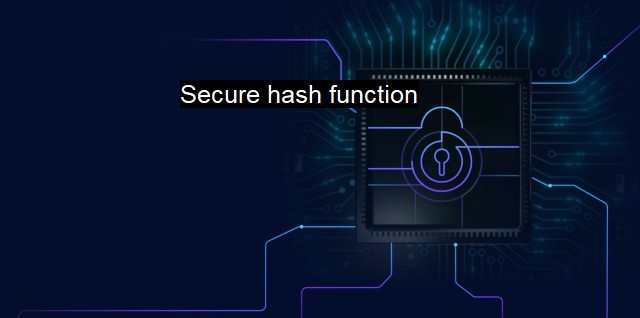What is Secure hash function?
Examining the Importance of Secure Hash Functions in Cybersecurity: Implications for Antivirus Software
"Secure hash function" is a commonly used term in cybersecurity and antivirus but understanding it requires a basic background on encryption and cybersecurity measures. Encryption has always been an integral part of cybersecurity, creating a secure method for information to be transmitted over potentially insecure networks without being able to be intercepted or deciphered by unauthorised parties. Secure hash functions are one advancement in the field of encryption that defend systems against a myriad of cyber threats and attacks.To delineate what a secure hash function is, one first needs to understand what hashing is in the context of cybersecurity. Hashing is a process utilized in cryptography that takes an input (or 'message') and returns a fixed-size string of bytes, which is typically a 'digest'. The digest is intended to be unique to every different input where even miniscule differences, like variations of a single character, can result in drastically different digests.
The safekeeping factor in this process is related to the principle that the 'digest' can’t be used to regain the original input data. This one-way conversion is what makes hashing exceptionally suitable for password security and data integrity checks. The predictable and consistent nature of this corresponding output-digest relationship in the hash mechanism means that repeated hash requests of the same input will always render the same digest.
This brings us to the main concept at hand: the secure hash function. A secure hash function takes the process of creating hashes, but elevates it to a higher level of security. It introduces properties that accord it exceptional value in password security, data integrity checks, digital signatures, generating pseudo-random bits, deriving new keys from a given master key, and identifying malicious changes to data during transmission.
There are three key properties that a secure hash function must have.
The first is pre-image resistance, which means that it should be computationally infeasible to generate the original input value when given only the hash output. This is crucial for ensuring secure storage of things such as password data, where even if the hash value is accessed unauthorizedly, it cannot be reverted into the original input.
The second property is the hash function’s ability to be collision-resistant. it shouldn't be computationally feasible to locate distinctive inputs that hash to the identical output. Because of the fixed size of hash outputs, collision avoidance is impossible. it should be so unlikely that it is practically impossible to find two colliding inputs.
The third and final property is its capability to be second-preimage resistant. This implies that given a specific input, an unauthorized party cannot feasibly discover a different input with the same hash value.
Coming to exemplars, the Secure Hash Algorithm (SHA) family, and Message-Digest Algorithm 5 (MD5) are examples of secure hash functions that have been pervasively used. barebones MD5 is no longer secure against a well-funded attacker because of vulnerabilities in its hash function that enable collision and pre-image attacks. The most secure subsets of the SHA family are now the de-facto standard for most cryptographic hash requirements.
Conclusively, in the arena of cybersecurity and antivirus technology, secure hash functions play an incalculably vital role. By facilitating a proven method to encode information securely, they form the bedrock upon which antivirus software package's integrity is assessed, encrypted data can be reliably decoded, and the key to original data can be securely maintained. Hybridising cryptographic fundamentals with advanced mathematical approaches, secure hash functions contribute a component to digital security that is pivotal in the contemporary digital world's persistent fight against cyber threats and malicious interceptions.

Secure hash function FAQs
What is a secure hash function in cybersecurity?
A secure hash function is a cryptographic algorithm that takes a message or data and produces a fixed-size output, known as a hash value or message digest. The hash value is unique for each input message and can be used to verify the integrity of the data.How does a secure hash function protect against viruses?
A secure hash function can be used to protect against viruses by creating a unique hash value for each file or program. If the hash value of a file changes, it indicates that the file has been modified or tampered with, which can be a sign of a virus or malware. Antivirus software can use hash values to compare files and determine if they are malicious or not.What are some examples of secure hash functions?
Some examples of secure hash functions include SHA-256, SHA-384, and SHA-512. These algorithms are widely used for data integrity checks, digital signatures, and password storage. Other hash functions like MD5 and SHA-1 are no longer considered secure due to vulnerabilities discovered over time.How can a secure hash function be implemented in cybersecurity?
A secure hash function can be implemented in cybersecurity by integrating it into different software and systems that require data integrity and protection. For example, many web applications use hash functions to store user passwords securely. In addition, organizations can use hash functions to ensure the integrity of critical data during transmission or storage.| | A | | | B | | | C | | | D | | | E | | | F | | | G | | | H | | | I | | | J | | | K | | | L | | | M | |
| | N | | | O | | | P | | | Q | | | R | | | S | | | T | | | U | | | V | | | W | | | X | | | Y | | | Z | |
| | 1 | | | 2 | | | 3 | | | 4 | | | 7 | | | 8 | | |||||||